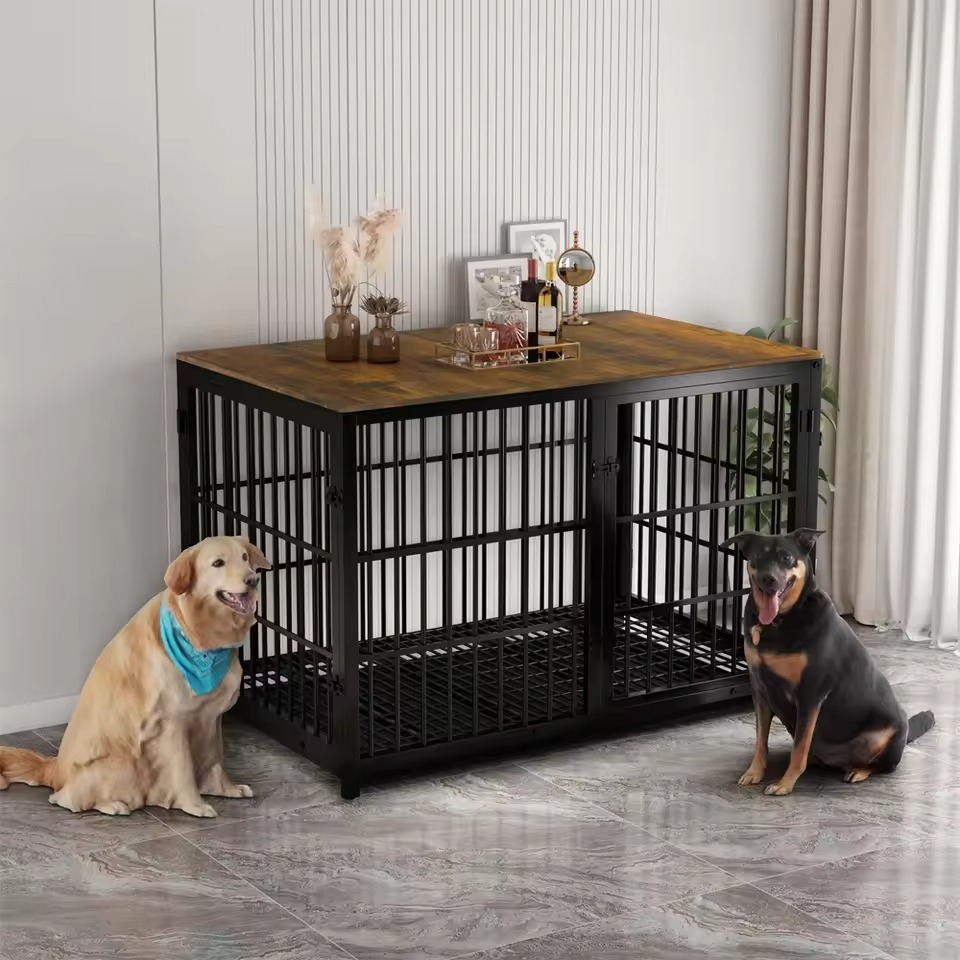Understanding Your Dog’s Kennel Needs
Before you pick a kennel, think about your dog’s individual needs. Each dog is different, and what works for one might not be right for another. Begin by assessing your dog’s size, breed, age, and temperament. These factors play a crucial role in determining the appropriate kennels. For example, active dogs might need more space to move around, while older dogs may require extra comfort.
Consider the amount of time your dog will spend in the kennel. Dogs that spend a lot of time indoors may need a different type of kennel compared to dogs who are outdoors more often. Also, think about the climate and weather in your area. Insulated kennels can protect your pet from extreme temperatures.
It’s also important to reflect on your dog’s behavior. If your dog tends to chew, a durable material is essential to prevent damage to the kennels. For escape artists, a secure locking mechanism is a must. Remember, the kennel is not just a housing space for your dog; it’s a place for them to feel safe and comfortable.
Lastly, factor in your own lifestyle and how the kennels will fit into your home environment. If you travel often, a portable kennel may be the best option. Or, if space in your home is limited, you’ll need to consider a kennels that is space-efficient. By understanding your dog’s kennel needs and matching them with your lifestyle, you can ensure the perfect fit for your furry friend.

Types of Kennels and Their Advantages
When choosing the perfect kennel, it’s essential to know the different types available. Each type of kennel offers unique benefits suited for various needs and environments. Here’s a breakdown of the most common types of kennels and their advantages:
Standard Kennels
Standard kennels are the classic choice for many dog owners. They typically come in metal or plastic. Metal kennels are sturdy and provide excellent ventilation. However, plastic kennels are lighter, making them ideal for travel. Both options are relatively easy to clean and maintain.
Travel Kennels
For owners who frequently travel with their pets, travel kennels are indispensable. These kennels are generally lightweight and designed for easy transport. They often conform to airline specifications for air travel. This makes them perfect for trips with your furry friend.
Wooden Kennels
Wooden kennels are not just functional; they are also aesthetically pleasing. They blend well with outdoor and indoor decor. Many wooden kennels offer excellent insulation, which is beneficial in colder climates. However, they require more maintenance to prevent rot and pest infestation.
Soft-sided Kennels
Soft-sided kennels are another great option for travel. They are the lightest in weight and can fold down for easy storage. Ideal for mild climates and indoor use, they provide a cozy space for your dog to rest. However, they might not withstand the wear and tear from vigorous dogs.
Heavy-duty Kennels
Designed for dogs that are strong or have a tendency to escape, heavy-duty kennels are made from reinforced materials. These kennels often feature secure locks and robust metal construction to prevent breaking out. They are ideal for keeping your pet safe and contained.
In essence, picking the right kennels depends largely on your specific needs, your dog’s nature, and the typical environment it will be in. Each type offers its own set of advantages that cater to different situations and needs.

Size Matters: Choosing the Right Dimensions
The size of the kennel is crucial for your dog’s comfort. Consider your dog’s growth, especially if they are still a puppy. A kennel should be spacious enough for your dog to stand, turn around, and lie down comfortably. Measure your dog from nose to tail and add a few inches to determine the ideal kennels length. The height of the kennel should allow your dog to stand without crouching.
For small dogs, a kennel measuring about 24 inches might be sufficient. Medium-sized dogs often fit well in a 36-inch kennel. Large dogs may need a kennels that is 42 inches or larger. Keep in mind that too much space can make a dog feel insecure, so don’t choose a kennel that is excessively large.
Remember to consider the kennel size not just for your dog, but also the space where it will be placed in your home. Ensure there is enough room around the kennel to position it properly without obstructing pathways.
Material Durability and Comfort
Choosing the right kennel involves more than just size and type. The material of the kennels greatly affects both its durability and the comfort it provides to your dog. Here are key points to consider:
- Metal Kennels: They are highly durable and offer great ventilation. However, they can be cold in the winter and hot in the summer without proper insulation.
- Plastic Kennels: These are lighter and easier to move around. They provide good insulation, making them suitable for moderate climates. Still, they may not withstand chewing or harsh weather as well as metal kennels.
- Wooden Kennels: Wooden models offer excellent insulation and blend beautifully with home and garden décor. They do require regular maintenance to prevent damage from moisture and pests.
- Soft-sided Kennels: Ideal for indoor use and travel, these kennels are comfortable and lightweight. They are not suitable for vigorous dogs or extreme weather conditions.
- Heavy-duty Kennels: Made with reinforced materials, these kennels are designed to handle escape artists and very active dogs. They ensure safety and durability under rigorous conditions.
When selecting a kennel, consider how each material will interact with your local climate and your dog’s behavior. A comfortable and durable kennel is crucial for your dog’s wellbeing and safety.
Location and Placement of the Kennel
Deciding where to place your dog’s kennel is as important as selecting the right type and size. You need to think about a few factors to ensure the location is optimal. Here’s what to keep in mind:
- Indoors or Outdoors: Determine whether the kennels will be inside or outside. Inside kennels provide more comfort in extreme weather. Outdoor kennels need sturdy construction to withstand the elements.
- Quiet and Low-traffic Area: Place the kennel in a spot away from busy areas. A calm location helps reduce stress for your dog.
- Protection from Weather: If outside, choose a sheltered area. This protects your pet from rain, wind, and harsh sun. Inside, avoid placing the kennels near drafty windows or heat sources.
- Easy Access: Ensure the kennel is easily accessible for cleaning and feeding. Also, think about whether your dog can enter and exit without trouble.
- View of Surroundings: Dogs often feel comfortable when they can see their surroundings. Position the kennel so your dog has a clear view of the area.
- Safety: Keep the kennel away from any hazards. Look out for things like toxic plants or open water sources.
- Integration into Your Space: Consider how the kennel will fit with your living arrangements. It should not block pathways or be an obstacle in your living area.
Placement is about finding a balance. Your dog’s kennel should be secure, comfortable, and seamlessly integrated into your space. Keep your pet’s nature and your home layout in mind when deciding on the ideal location.

Essential Features to Look For
When selecting a kennel, certain features are essential. Here are some key traits to consider:
- Proper Ventilation: Ensure the kennel has adequate airflow. Good ventilation keeps your dog cool and comfortable.
- Sturdy Latches and Locks: Choose a kennels with reliable locks. This prevents your dog from escaping and ensures their safety.
- Ease of Cleaning: Opt for kennels with smooth surfaces and drainage systems. These features make cleaning easier and maintain hygiene.
- Comfy Bedding: Look for kennels that can accommodate soft bedding. Comfortable bedding helps your dog rest better.
- Water-Resistance: If the kennel is outdoors, ensure it resists water. This keeps the kennel dry during rainy days.
- Chew-Proof Materials: If your dog chews, select a kennel made from chew-resistant materials. This adds to the kennel’s durability.
- Adjustable Dividers: For growing puppies, adjustable dividers help the kennel grow with your dog. They provide the right space as your dog grows.
By focusing on these features, you can select a kennel that meets both your and your dog’s needs.
Maintenance and Cleaning Tips
Maintaining and cleaning your dog’s kennel keeps it safe and comfortable. Here are practical tips:
- Regular Cleaning: Clean the kennel regularly to eliminate dirt and germs. Use mild soap and water.
- Disinfect: Once a week, disinfect the kennel to prevent disease. Use a pet-safe disinfectant.
- Check for Damage: Inspect the kennel for any structural damage. Repair or replace damaged parts immediately.
- Control Odor: Use deodorizers designed for pet areas to keep the kennel smelling fresh.
- Dry Properly: After cleaning, ensure the kennel is completely dry before letting your dog use it again.
- Remove Bedding: Wash your dog’s bedding weekly. Regular washing helps prevent skin irritations and infections.
- Keep Hygienic: Place feeding bowls outside the kennel to keep it cleaner.
Following these steps will help extend the life of the kennel and provide a hygienic space for your dog.
Safety Considerations When Using a Kennel
When using a kennel, safety is a top priority. Here are several considerations to keep in mind:
- Proper Assembly: Always assemble the kennels correctly. Follow the manufacturer’s instructions to avoid gaps or loose parts that could harm your dog.
- Location Safety: Place the kennel in a safe area. Make sure it’s away from potential hazards like toxic plants, sharp objects, and open water.
- Routine Checks: Regularly inspect the kennel for signs of wear or damage. Replace or repair any broken parts immediately.
- Correct Size: The kennels size should suit your dog. Too small and they can feel cramped; too large and they might feel insecure.
- Ventilation: Ensure the kennel is well-ventilated. Good air circulation prevents overheating and keeps the environment fresh.
- Secure Locks: Use kennels with sturdy locks to prevent your dog from escaping. Check that the locks are functioning well.
- Avoid Choking Hazards: Don’t leave items that could be choking hazards inside the kennel, such as toys or bones.
- Supervision: When possible, keep an eye on your dog while they are in the kennels, especially if they are new to it.
By keeping these safety tips in mind, you can create a secure and pleasant environment for your dog while in their kennel.










